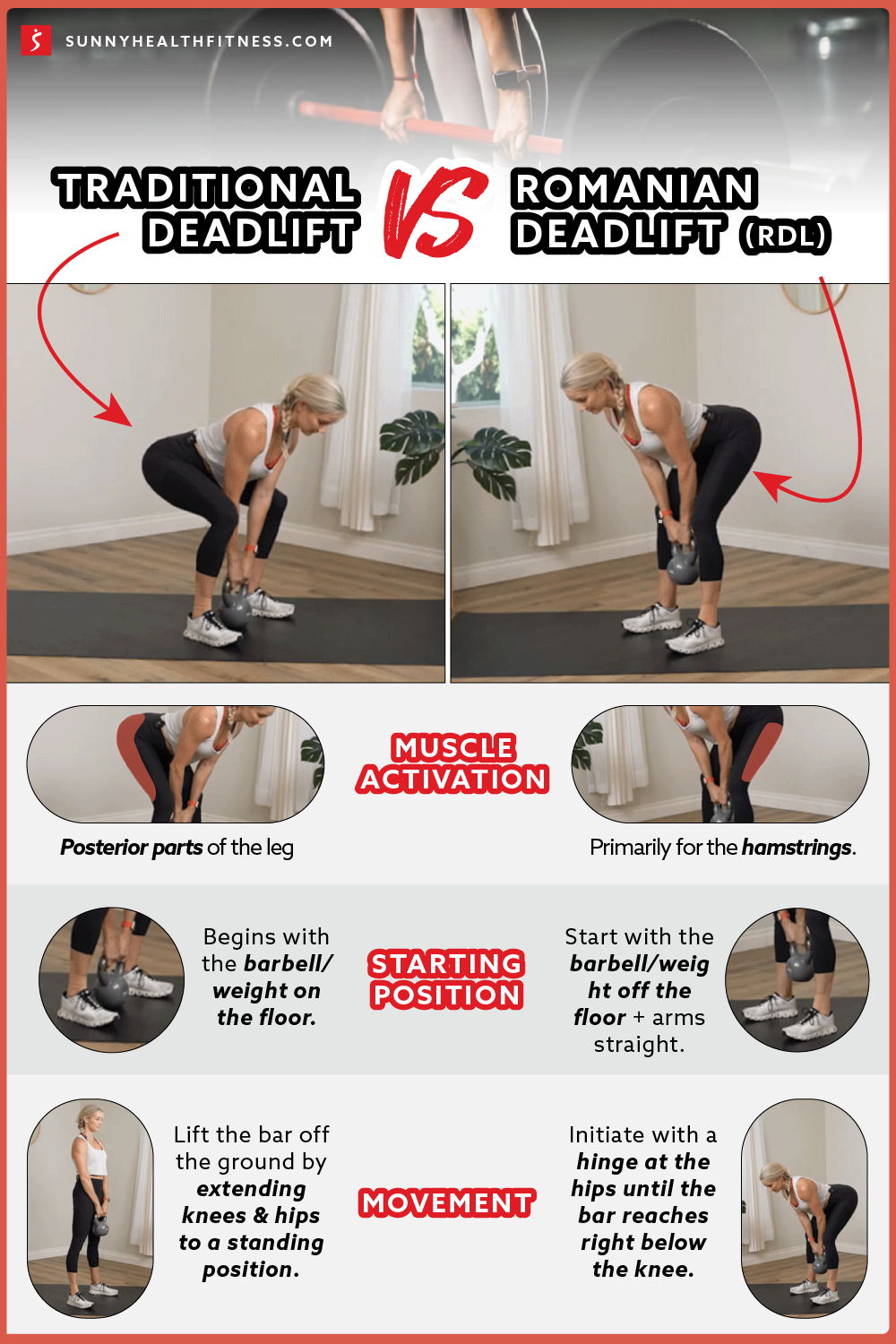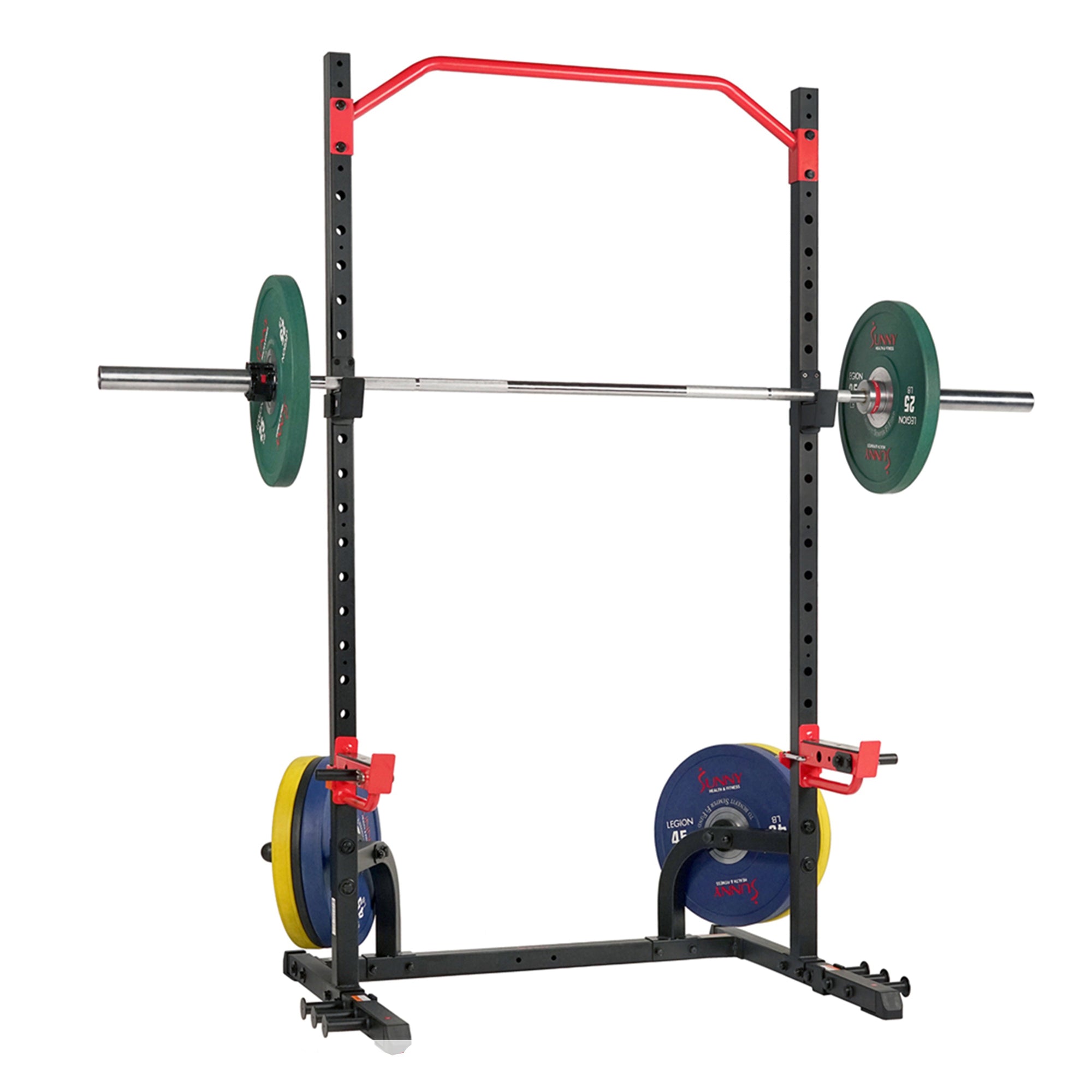If you’re looking to build strength, deadlifts are a must-have in your workout routine. There are many different deadlift variations, but traditional deadlifts and Romanian deadlifts (RDL) are among the most popular. We divulge what makes these two variations different, how to perform them, and when to perform them below.
What is a Deadlift?
What is a deadlift, some might ask? If you work out and enjoy weightlifting, a deadlift should be a part of your workout routine. Deadlifts are a highly effective compound, multiple joint movements for increasing total-body strength & power. There are many variations of the deadlift, and all deadlift variations can help train the posterior chain muscles, rehabilitate knee injuries, and reduce the risk of low back pain. Because the lift can be performed with heavy loads, a significant mechanical stimulus is placed on the body, lending itself well to strength and power adaptations.
A deadlift is a valuable tool used in postoperative and nonsurgical rehabilitation protocols. The weighted barbell bar remains anterior to the lifter’s center of mass, meaning there is greater demand for the erector spinal muscles to stabilize the spine when compared with other compound free-weight exercises. The exercise has been shown to reduce the risk of anterior cruciate ligament (ACL) injury and low back pain (1). The deadlift is one of three events seen in the sport of powerlifting and is incorporated into weightlifting programs as a supplemental movement.
What is a Traditional or Conventional Deadlift?
The deadlift is a free weight exercise bar in which a barbell is lifted from the floor by extending the knees, hips, and ankles. Typically, the term deadlift is associated with the conventional deadlift and is characterized by a shoulder-width stance of the feet and arms outside the thighs. Due to its ability to develop full-body strength, the deadlift has been called one of the “Big Three” (Squat, Bench Press, and Deadlift) in gaining total body strength. When performing deadlifts, multiple agonists are activated simultaneously, specifically at the knee and hip, where knee flexors, extensors, and hip extensors are all activated throughout the lift. For example, the hamstrings serve as knee stabilizers and hip extensors, while the quadriceps work as knee extensors in the ascending phase. The traditional deadlift attempts to activate much lower body musculature in developing strength. However, several variations of the deadlift exist, with each exercise targeting specific muscle groups (2).

What is a Romanian Deadlift or RDL?
Romanian deadlift (RDL) is unique in the fact that the starting position is standing, similar to the starting position of a Hang Clean. An RDL is initiated by lowering the bar by hinging at the hips, moving through a full range of motion, before finishing back at a standing position. This movement is essential in developing movement proficiency in weightlifting. Because the RDL establishes the correct body positioning (stance and posture) through initiation of the posterior chain segment of the hips, buttocks, and hamstrings (low back-hip hinge), it requires lifters to maintain optimal alignment.
Many think that a straight-legged deadlift (also known as an SLD) is the same as a Romanian deadlift (RDL), but I’m here to tell you that they are two different exercises. The difference is that with a straight-legged deadlift, your legs are straight. An RDL, on the other hand, has a 15-degree knee flexion with a slight bend.

What are the Differences Between a Conventional Deadlift vs. an RDL?
Biomechanical Differences
The biomechanical differences between a conventional deadlift vs. an RDL can be found in the technical difference between the two movements. An RDL is performed for training the posterior part of the leg. In contrast, the hamstrings and gluteals are agonists during a conventional deadlift since the muscles serve as knee stabilizers and hip extensors (2). The activity in the lower extremities from a conventional deadlift will activate the rectus femoris, bicep femoris, and gluteus maximus, whereas an RDL is performed primarily for training hamstrings. A conventional deadlift will also show different muscle dominance at the knee than an RDL.
Technique Difference
When performing an RDL, you start your movement with the barbell off the floor and arms straight. At the same time, the starting position for a traditional deadlift begins with the barbell on the floor. The second main technique difference is the concentric (upward movement) & eccentric (lowering motion) movement. With a conventional deadlift, the concentric movement requires you to lift the bar off the ground by extending your knees & hips to a standing position, then allowing the hips and knees to flex as you lower the bar back down to the earth. For an RDL, the eccentric movement is initiated with flexion or hinge at the hips until the bar reaches right below your knee.
RDL & Conventional Deadlift Similarities
The starting position for both an RDL & conventional deadlift is essential to execute both exercises safely. All deadlift variations should be conducted in a slow, controlled manner. Both movements are initiated by lowering the bar through hip flexion and moving through a full range of motion (ROM) before ending back in the standing position. To enhance safety and practical learning, lifters unfamiliar with performing the deadlift should use either unloaded or lightly loaded bars to learn the right place and develop proper exercise techniques.
How to do a Conventional Deadlift
Setup and Starting Position:
- The bar should be positioned on the floor, directly over the balls of the feet, approximately 1 to 2 inches from the vertical shin.
- Stand with your feet flat and place between hip & shoulder-width apart. Toes should be pointed forward or slightly outward.
- With a slight bend in the knees, bend down toward the bar, letting the hips move directly backward in a “hinging” motion. While bending over to the bar, the knees should remain stationary, and your shins should remain in a vertical position.
- Grab the bar with a double overhand grip, placing the hands slightly wider than shoulder-width apart & outside of the knees. Keep elbows fully extended.
- Lower the hips into the final starting position by allowing the knees to move forward until the shins touch the bar. The head and the neck are aligned with the trunk by focusing the eyes slightly downward. The back should be flat to maintain a neutral spine.
- The chest should be held up and out, creating slight tension in the upper back to prevent rounding.
Movement:
Concentric (Upward Motion)
- While keeping the head neutral, the torso rigid, and the arms fully extended, lift the bar off the floor by extending your hips and knees.
- Keep tension in your hips, driving your feet into the floor to move the bar upward.
- Once the bar reaches the knees, extend your hips forward to move your thighs towards the bar. Continue to grow the hips and knees until the body gets standing.
Eccentric (Downward Motion)
- From a standing position, allow your hips and knees to bend, lowering the bar down to the floor. Maintain a neutral head and flat back position until the bar and weights are back to the floor.
How to do a Romanian Deadlift (RDL)
Setup and Starting Position:
- Unrack the bar or perform a proper conventional deadlift to get into a standing position with the bar in hand and arms extended straight.
- Stand with your feet flat and placed between hip & shoulder-width apart with toes pointed forward. Hands should be approximately shoulder-width apart and slightly on the outside of the thighs.
- Your head should be in a neutral position. The chest should be up and out with your scapula retracted to create tension in the upper back musculature.
- Knees will have a slight bend, approximately 15°.
Movement:
Eccentric (Downward Motion)
- This movement is initiated with a hinge at the hips.
- While the hips move backward, the bar is slowly lowered, keeping the weight close to the thighs instead of under-neath the shoulders, coming to a 45° angle with the chest and back.
- Lower the bar until it reaches right underneath your knee.
Concentric (Upward Motion)
- For the upward phase of the lift, extend the hips back to a standing position, with a slight knee bend and flat back position. Avoid hyperextending or jerking the torso backward.
Why Do a Traditional Deadlift vs. Romanian Deadlift
Although it is commonly believed that an RDL is a superior exercise for training the hamstrings when compared to the conventional deadlift, research has shown no significant differences in muscle activity produced in the biceps femoris between the two. However, research has shown more substantial movement in the gluteus maximus with the conventional deadlift over an RDL.
When choosing a deadlift exercise variation, comfort is critical, and should be the first consideration when choosing the exercises to incorporate into your regular routine. Implement exercises that you can repeatedly perform without pain or discomfort.
(1) Understanding The Deadlift and Its Variations, Journal, 2020.
(2) An Electromyographic and Kinetic Comparison of Conventional and Romanian Deadlifts, Journal, 2018.


























Add Your Name & Email
Please enter your name and email to continue.We won’t display your email publicly.